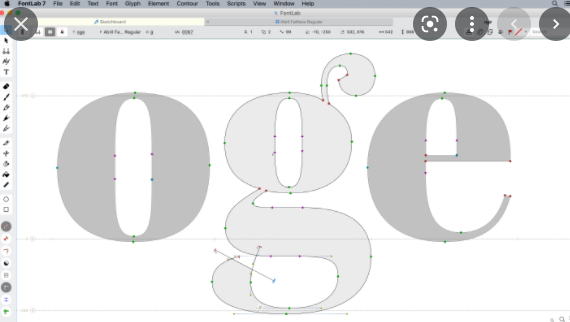SoftUnion released FontLab 2.5 for Windows in 1994. This version included many enhancements including TrueType font editing. FontLab rose to the top of its class, becoming the most advanced font editor for Windows. FontLab has been used by thousands of font designers and software developers, as well as large font and font manufacturers. Graphic designers and students love our apps.
Fontlab Fontographer
Password 123
This is an excellent option for beginners who want to start designing typefaces or creating/modifying fonts without making a large investment. After a major rewrite, FontLab 3.0 for Windows was released in June 1998. FontLab 7 allows you to space, kern, and draw glyphs within its unified windows. You can create complex spacing relationships using metrics links, view kerning class as you kern, and apply OT features for space & kern alternatives. You can dock windows into tabs and float them across screens in stunning Retina/High DPI quality. Fontlab Ltd. purchased all assets of Pyrus NA in January 2000 with the intent of expanding international sales. Fontlab Ltd. continues to develop its FontLab product line. In 2001, TransType 2 was released as an upgrade for FontLab’s font conversion software. BitFonter is a new product that allows you to edit and create bitmap fonts.

Rapid is ideal for drawing consistent shapes quickly or intelligently tracing a background or scan. For live, customizable calligraphy strokes, use the Powder Brush to create a “skeleton contour”. Adjust the thickness and angle of the brush after you draw. Power Brush presets can be saved and applied to other contours in your font.
FontLab’s new interface and powerful tools will make it easier to work faster. FontLab will save your Components when you export to TTF/UFO and convert Element References into Components whenever necessary. Drag-and-drop or paste pixel images into any format, including mono, grayscale and full color, as well as transparency support. For proofing purposes, you can arrange text frames that show different fonts. You can also export the contents to a PDF or SVG. Use the fill tool to fill the areas formed by their intersections. Alt+click to unfill and click to fill. The manual setting of path direction in the 1980s.
FontLab 2.0 unleashed creativity in computer-based graphic designers. This group was a new and growing one. You can link metrics and create complex spacing relationships using our live math expressions engine. The sidebearings will stay constant, even when you change an outline. FontLab offers a variety of drawing tools that can be used to create an outline.
You can draw curves using the Bezier Pen tool, or you can use the Curve Corner Tangent, Tangent, and Arc tools to create your outline step by step. Use the Ellipse and Polygon tools to draw geometric shapes. Use the pressure-sensitive Calligraphy Pen to draw calligraphic strokes.
It took me less than a month to realize that I actually liked working in it. One window can be used for all things, including glyph editing and testing the font in long texts. You can zoom in or switch between modes to make it easier. TheVariationspanel allows you to view and control the extrapolation and interpolation results. layers & Masterspanel allows you to switch between the glyph layers representing font masters or glyph-specific correction master. Automatically find and equalize irregular stems within a glyph. Automatically convert nearly flat curves to lines by finding them. If you find the traditional Bezier pen too difficult, you will love our other drawing tools.
Multilingual Fonts
FontLab 7 allows you to visualize curve tension. You can also edit it numerically and visually. The Rapid tool even lets you draw curves with the tension you choose. FontLab 7 is able to help you create a font that has more square curves, such as Helvetica and Eurostile. FontLab 7 can be downloaded as a fully functional 30-day trial. Auto Kern can automatically generate kerning pairs for glyph pairs that require placement correction.
You can re-use small pieces of the design within glyphs, or across multiple glyphs using Element References and Gallery. There is no need to create separate Element References for each design fragment. You can edit an Element referenced anywhere it appears, or unlink a reference to make only local changes. To see your kerning plan and the Kerning panel, use the Pairs & Phrases panel. OpenType kerning optimized for KLTF export that doesn’t break or overflows.
It can be difficult to duplicate several preferences settings in order to produce a particular font. FontLab 7 is extremely fast because it was written in C++. We reduced the lag in some cases from minutes to milliseconds.
You can easily plan your Instances to use a large font family or a variable font. FontLab automatically creates a matrix for each axis with the correct Style names, Style groups, and interpolation locations. FontLab 7 allows you to create accented letters quicker using anchors or auto layers. With OpenType Layout tables, you can add small caps and ligatures as well as alternate glyphs to complex scripts like Arabic.
Each glyph is displayed when you type text in a font. The advanced width of each glyph affects the position of your cursor. If there is a kerning pairing between two glyphs the placement of the second glyph is affected by the value of the kerning couple. Sidebearings are the distances between contours and advanced widths on each side of the glyph.
Fontlab Fontographer System Requirements
- Memory (RAM): 512 MB of RAM required.
- Operating System: Windows 7/8/8.1/10
- Processor: Intel Pentium 4 or later.
- Hard Disk Space: 50 MB of free space required.
